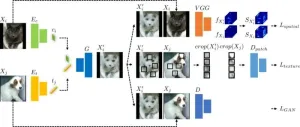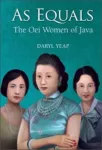(Press-News.org) □ Daegu Gyeongbuk Institute of Science and Technology (DGIST), led by President Yang Kuk, announced on September 6, 2023 (Wednesday) that the research team of Professor Sang-hyun Park at the Department of Robotics and Mechatronics Engineering had developed a new image translation model that could effectively reduce biases in data. In the process of developing an artificial intelligence (AI) model using images collected from different sources, contrary to the user’s intention, data biases may occur because of various factors. The developed model can remove data biases despite the absence of information on such factors, thereby providing a high image-analysis performance. This solution is expected to facilitate innovations in the fields of self-driving, content creation, and medicine.
□ The datasets used to train deep learning models tend to exhibit biases. For example, when creating a dataset to distinguish bacterial pneumonia from coronavirus disease 2019 (COVID-19), image collection conditions may vary because of the risk of COVID-19 infection. Consequently, these variations result in subtle differences in the images, causing existing deep learning models to discern diseases based on features stemming from differences in image protocols rather than the critical characteristics for practical disease identification. In this case, these models exhibit high performance based on data used for their training process. However, they show limited performance on data obtained from different places owing to their inability to effectively generalize, which can lead to overfitting issues. Particularly, existing deep learning techniques tend to use differences in textures as crucial data, which may lead to inaccurate predictions.
□ To address these challenges, Prof. Park’s research team developed an image translation model that could generate a dataset applying texture debiasing and perform the learning process based on the generated dataset. Existing image translation models are often limited by the issue of texture changes leading to unintended content alterations, as textures and contents are intertwined. To address this issue, Prof. Park’s research team developed a new model that simultaneously uses error functions for both textures and contents.
□ The new image translation model proposed by this research team operates by extracting information on the contents of an input image and on textures from a different domain and combining them. To simultaneously maintain information on not only the contents of input images but also the texture of the new domain, the developed model is trained using both error functions for spatial self-similarity and texture co-occurrence. Through these processes, the model can generate an image that has the texture of a different domain while maintaining information on the contents of the input image.
□ As the developed deep learning model generates a dataset applying texture debiasing and uses the generated dataset for training, it exhibits a better performance than the existing models. It achieved a superior performance compared to existing debiasing and image translation techniques when tested on datasets with texture biases, such as a classification dataset for distinguishing numbers, classification dataset for distinguishing dogs and cats with different hair colors, and classification dataset applying different image protocols for distinguishing COVID-19 from bacterial pneumonia. Moreover, it outperformed existing methods when applied to datasets with various biases, such as a classification dataset for distinguishing multi-label numbers and that for distinguishing photos, images, animations, and sketches.
□ Furthermore, the image translation technology proposed by Prof. Park’s research team can be implemented in image manipulation. The research team found that the developed method altered only the textures of an image while preserving its original contents. This analytic result confirmed the superior performance of the developed method compared to existing image manipulation methods. Additionally, this solution can be effectively used in other environments. The research team compared the performance of the developed method with that of existing image translation methods based on various domains, such as medical and self-driving images. Based on the analytical results, the developed method demonstrated a more excellent performance than existing methods.
□ Prof. Park stated, “The technology developed in this research offers a significant performance boost in situations where biased datasets are inevitably used to train deep learning models in industrial and medical fields.” He also added, “It is expected that this solution will make a substantial contribution to enhance the robustness of AI models commercially used or distributed in diverse environments for commercial purposes.”
□ The results of this research were recognized for their excellence and published in Neural Networks, a prestigious journal in image analysis, in August 2023.
corresponding author E-mail Address : shpark13135@dgist.ac.kr
END
DGIST develops an artificial intelligence model for effectively removing biases in a dataset
2023-10-31
ELSE PRESS RELEASES FROM THIS DATE:
Breaking glass ceilings instead of feet
2023-10-31
In a time when bound feet, arranged marriages, and subservience were prevalent, Hui-lan, Ida, and Lucy forged a path that broke free from cultural stereotypes. They skilfully flew airplanes, managed Asia's most opulent estates, and charmed the Western world with their impeccable sense of style and sophistication. Their courage and determination not only shattered stereotypes but also paved the way for countless others to follow in their footsteps.
Daryl Yeap, a celebrated author and historian, invites readers on a captivating journey into the lives of three remarkable women—Hui-lan, Ida, and Lucy—in her upcoming book, As Equals: The Oei ...
$20 million grant from the National Cancer Institute enables research into youth e-cigarette and oral nicotine use at USC
2023-10-31
USC faculty members Adam Leventhal, PhD and Caryn Lerman, PhD have received a $20 million grant for research to inform government regulations overseeing tobacco and its marketing, with a focus on protecting young people. The USC Tobacco Center of Regulatory Science (TCORS), an interdisciplinary initiative led by the USC Institute for Addiction Science (IAS), USC Norris Comprehensive Cancer Center and the Department of Population and Public Health Sciences at the Keck School of Medicine of USC, is one of seven programs nationwide to receive funding provided jointly by the Food ...
Groundbreaking study reveals link between air pollution and incidence of Parkinson’s disease
2023-10-31
A new study led by researchers at Barrow Neurological Institute has found that people living in regions with median levels of air pollution have a 56 percent greater risk of developing Parkinson’s disease compared to those living in regions with the lowest level of air pollution.
The study, which will be published online on Monday, Oct. 30 in Neurology - the medical journal of the American Academy of Neurology - was conducted to identify national, geographic patterns of Parkinson’s disease and test for nationwide and region-specific associations with fine particulate matter.
“Previous studies ...
Australasia’s hidden pollination crisis could threaten biodiversity and food security
2023-10-31
Australasia has likely overlooked a pollination crisis, according to new research published today in the journal Ecology and Evolution. The research, led by Macquarie University, also underscores a pressing need for intervention to avoid biodiversity loss and long-term food insecurity in the region.
The authors analysed thousands of research papers on human-induced pollinator decline globally, and found despite only a tiny portion mentioning Australasia, the causes of pollinator decline in the northern hemisphere were mirrored in this region.
Research in Europe and North America finds threats that include ...
Late not great – imperfect timekeeping places significant limit on quantum computers
2023-10-30
New research from a consortium of quantum physicists, led by Trinity College Dublin’s Dr Mark Mitchison, shows that imperfect timekeeping places a fundamental limit to quantum computers and their applications. The team claims that even tiny timing errors add up to place a significant impact on any large-scale algorithm, posing another problem that must eventually be solved if quantum computers are to fulfil the lofty aspirations that society has for them.
It is difficult to imagine modern life without clocks to help organise our daily schedules; with a digital clock in every person’s smartphone or watch, we ...
COVID vaccination in female, male partners does not increase risk of miscarriage
2023-10-30
Multiple studies have shown that the COVID-19 vaccines do not lead to infertility or pregnancy complications such as miscarriage, but many people are still wary of adverse effects from the vaccine on pregnancy.
A new study led by Boston University School of Public Health (BUSPH) researchers now provides deeper insight into the safety of COVID-19 vaccines for people planning to become pregnant.
Published in the journal Human Reproduction, the study found no increased risk of early or late miscarriage as a result of male ...
First clinical classification of heart attacks based on tissue damage adopted by Canadian Cardiovascular Society
2023-10-30
INDIANAPOLIS, IND – The Canadian Cardiovascular Society (CCS) released the world’s first classification of acute myocardial infarction (AMI), or heart attack, based on heart tissue damage research that was driven by two cardiovascular investigators within the Ischemic Heart Disease Program of Krannert Cardiovascular Research Center (KCVRC) at Indiana University School of Medicine and Northern Ontario School of Medicine.
The four-stage classification, CCS-AMI, was presented at the Vascular 2023 conference on Oct. 29 in Montréal, Canada, and published ...
Microplastics’ shape determines how far they travel in the atmosphere
2023-10-30
ITHACA, N.Y. –Micron-size microplastic debris can be carried by the jet stream across oceans and continents, and their shape plays a crucial role in how far they travel.
A Cornell University collaboration has developed a model to simulate the atmospheric transport of microplastic fibers and shows that flat fibers travel farther in the lower atmosphere, and are more prevalent, than spherical fibers. Previous studies assumed these fibers to be spherical.
The modeling has the potential to help scientists determine the sources of the pervasive waste – which could inform policy efforts to reduce it.
The ...
Can personalized care prevent over screening for colorectal cancer in older adults?
2023-10-30
Colorectal cancer screening is widely recommended for adults ages 45 to 75 with an average risk of developing the disease. However, many people don’t realize that the benefits of screening for this type of cancer aren’t always the same for older adults.
“While many clinicians simply follow guideline recommendations for colon cancer screening in adults within this age range, this isn’t always the best approach,” said Sameer Saini, M.D., M.S., who is a gastroenterologist at both Michigan Medicine and the Lieutenant Colonel Charles S. Kettles VA Medical Center and is as a health ...
The Crab Nebula seen in new light by NASA's Webb
2023-10-30
NASA’s James Webb Space Telescope has gazed at the Crab Nebula, a supernova remnant located 6,500 light-years away in the constellation Taurus. Since the recording of this energetic event in 1054 CE by 11th-century astronomers, the Crab Nebula has continued to draw attention and additional study as scientists seek to understand the conditions, behavior, and after-effects of supernovae through thorough study of the Crab, a relatively nearby example.
Using Webb’s NIRCam (Near-Infrared Camera) and MIRI (Mid-Infrared Instrument), a team led by Tea Temim at Princeton University is searching for answers about the Crab Nebula’s ...


